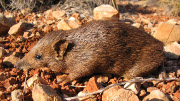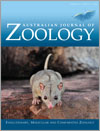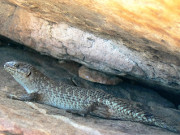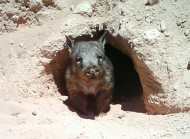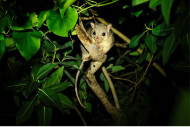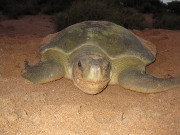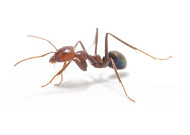Australian Journal of Zoology
Volume 64
Number 3 2016
This literature review of bandicoots and bilbies (Marsupialia; Peramelemorphia) examines advances in the knowledge of the biology of this group over the past 25 years, including anatomical, physiological and ecological studies and a comprehensive review of the fossil records of bandicoots to provide an up-to-date platform for future studies.
Photo by W. J. Bancroft.
Space use is an important aspect of animal behaviour. This investigation of gidgee skink site fidelity found lizards that were larger in initial surveys were more likely to be recaptured, and a high proportion of those recaptured were close to their original capture sites. Why some lizards changed space while others didn’t is yet to be fully understood.
Photo by Sarah Pearson.
Dingo scents were trialled over 75 days to determine their influence on southern hairy-nosed wombats. Wombats lingered nearby, but ceased repopulating collapsed burrows. This represents a novel use for a deterrent, in that prey may remain in the vicinity near a deterrent, but curb problematic behaviours of economic consequence.
Photo by Elisa Sparrow.
Habitat selection and diet of the scaly-tailed possum (Wyulda squamicaudata) was examined in the north-west Kimberley, Western Australia. Rock complexity appears to be an important landscape attribute for Wyulda, as it may provide den sites and protect fire-sensitive landscape features such as fruiting trees and habitat heterogeneity.
Photo by Alex Hartshorne.
Marine turtle nesting activity in the Pilbara region of Western Australia is not well defined. Between 1992 and 2012, using the track census approach, surveys identified reproductive habitat and described species-specific abundance of adult flatback (Natator depressus), green (Chelonia mydas) and hawksbill (Eretmochelys imbricata) turtles at 154 locations in the Pilbara region of Western Australia.
Photo by Catherine Bell.
Trunk-trail-forming Iridomyrmex purpureus ants use odour trails, landmark information and a celestial compass for navigation. Experienced ants rely on landmark information and naïve ants rely on pheromone trails. Ants rely on the celestial compass only when familiar odours and terrestrial visual cues are absent.
Photo by Ajay Narendra.
